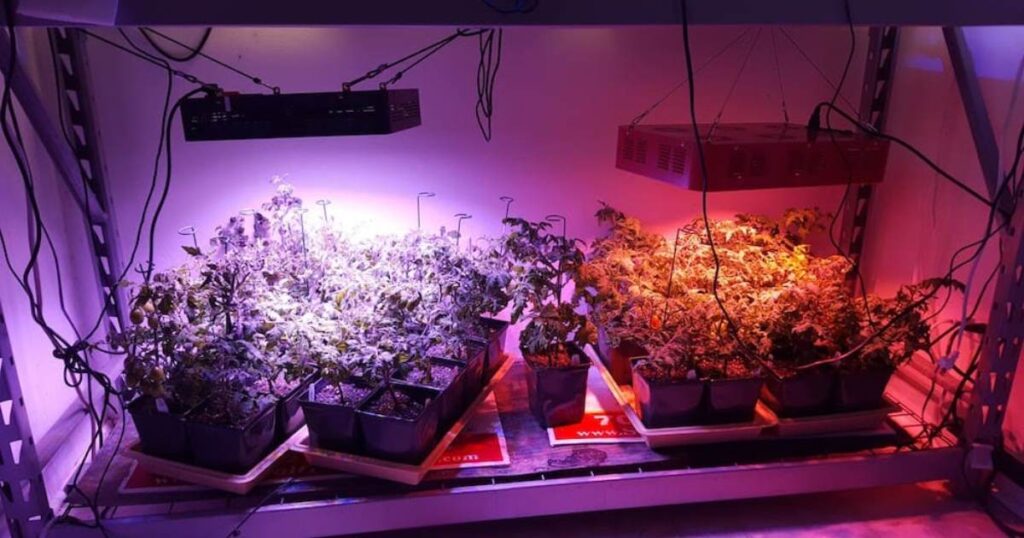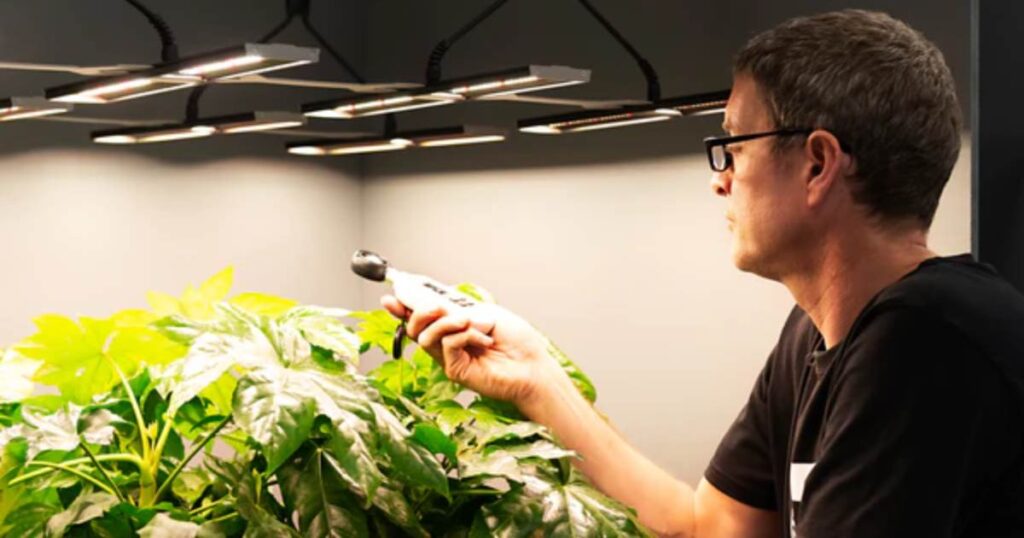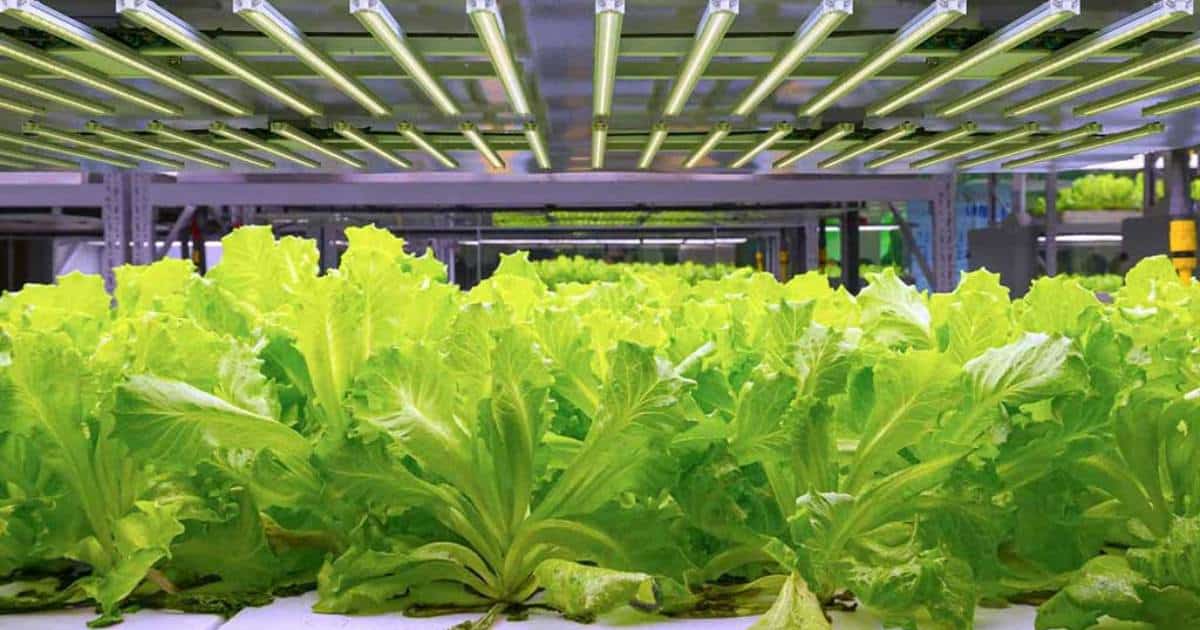Full spectrum LED grow lights utilize light-emitting diodes (LEDs) to emit wavelengths of light that mimic natural sunlight. Unlike traditional high-intensity discharge (HID) grow lights which emit primarily in the blue and red spectrums, full-spectrum LED lights provide a complete light spectrum that includes wavelengths with colors such as UV, blue, green, yellow, orange, and red.
The unique advantage of LED lights lies in their ability to emit specific wavelengths that correspond to chlorophyll’s light absorption peaks and other photoreceptors that drive photosynthesis.
Plants have evolved to utilize sunlight which contains an integrated combination of wavelengths. Full spectrum LEDs aim to deliver this optimal light recipe indoors.
Compared to other lighting technologies like HPS bulbs, CFLs, and fluorescent tubes, LED grow lights are more energy efficient, last significantly longer and produce less radiated heat.
This makes them an attractive option for indoor gardeners, commercial greenhouse growers, and cannabis cultivators seeking reliable, cost-effective plant lighting.
The Benefits of Full Spectrum LED Grow Lights
Improved Plant Growth and Higher Yields
Full-spectrum LEDs have been proven in studies to increase plant biomass, leaf area, and fruit/flower production compared to single-spectrum lights. This is due to advanced full-spectrum LED light’s ability to synthesize light across the entire PAR wavelength range that drives photosynthesis.
The result for indoor growers is larger, more robust plants that set higher yields.
Reduced Energy Costs
A key selling point of LED grow lights is their superior energy efficiency. On average, today’s top LED grow lights consume approximately half or less the power of equivalent high-pressure sodium (HPS) or metal halide (MH) fixtures. With electricity bills slashed, growers gain a faster return on investment.
Longer Lifespan
LED chips are rated to last 50,000-100,000 hours when used in controlled environments. In the world of grow lighting where bulbs typically burn out in 1-3 years, LEDs provide a durable, almost maintenance-free solution lasting up to a decade or more. Less frequent lighting replacements lower long-term costs.
Cooler Operation
Compared to traditional HID lighting emitting copious excess heat, LED arrays generate dramatically less thermal pollution. This allows indoor farmers to place lights closer to plants without risking thermal or light stress that hinders growth and yields. Less heat also improves room comfort.
Key Factors to Consider When Choosing LED Grow Lights
Light Spectrum
It is important to select a light with a spectrum covering 400-700nm including UV, blue (~450nm), green (~530nm), yellow (~570nm), orange (~590nm), and deep red (~660nm, ~730nm) wavelengths. Look for brands advertising spectrum optimized for vegetative growth, flowering, or both plant life stages.
Light Intensity
Intensity, measured as Photosynthetic Photon Flux (PPF) in μmol/m^2/s, should correspond to your plants’ individual needs and growth area. Seedlings require 200-400 PPF; vegetables 300-600 PPF; tomatoes 500-1000 PPF; cannabis 800-1600 PPF. Consider PPF ratings at 12″, 18″, and 24″ for proper light dissipation.
| Light Style | PPF Rating Distance |
| Entry-Level Lights | 300-600 PPF at 12-18” |
| Amateur/Home Grower | 600-1000 PPF at 18” |
| Commercial Greenhouse | 1000-1600 PPF at 24” |
Coverage Area
Ensure the fixture’s dimensions and wattage fully cover your grow space without overlapping or dark spots under the canopy. Most LED panels cover 1×1 to 4×4 footprint areas.
Cost
Prices for quality LEDs range from $100-$1000 depending on wattage, spectrum, and brand. Consider needs, electricity savings, and typical 2-3 year return on investment compared to HPS when budgeting.
Applications for Full Spectrum LED Grow Lights

Indoor Gardening
Full spectrum LEDs are ideal for growing all types of edible and ornamental plants indoors year-round including herbs, salad greens, microgreens, tomatoes, peppers, and flowers.
Seedling Propagation
Low-power white/blue LEDs provide optimal wavelengths and gentler light levels little seedlings require to photosynthesize and establish new root systems.
Hydroponics
LEDs precisely deliver spectrum and intensity profiles nutrient film technique (NFT), deep water culture (DWC), and other soilless systems demand for explosive plant growth.
Cannabis Cultivation
High-yield cannabis cultivars have become mainstream beneficiaries of LED technology’s spectrum control advancing plant structure and potency yields crucial for legal commercial production.
Choosing the Right LED Grow Light for You
Consider your space, plant varieties, growth stages, and expected output when shopping for full-spectrum LED grow lights.
Consult with hydroponic equipment specialists and seek LED brands with 3+ year warranties, replaceable parts, and third-party certifications such as PHYTOTRONIX, GE, and Lumigrow.
With the right fixtures, indoor farmers can control natural light variables and maximize plant production all year long.
Adjustable Spectrum LED Grow Lights
Many top grow light brands offer fixtures with adjustable switches, knobs, or smartphone apps to precisely tune light wavelength ranges. This allows tailoring the spectrum throughout a plant’s life.
For example, vegging seedlings under high-blue light and then ramping red wavelengths as flowering commences.
Brands like Kind LED and Growers Choice offer advanced controls to fine-tune light recipe balances down to customized percentages of individual colors. For example, 60% red, 30% blue, and 10% white light. This maximizes plant physiological responses at each growth stage.
LED Grow Lights Compare to Traditional HIDs
While HPS and MH bulbs dominated the industry for decades due to low startup costs, LED grow lights emerged as the superior long-term investment:
| Factor | HID | LED |
| Electricity Usage | Very High – 600W HPS uses 600 true watts | Low – 600W LED uses 300-400 true watts |
| Heat Output | Produces high amounts – risks heat stress | Broad spectrum across the PAR range |
| Spectrum | Narrow dominated by orange/red or blue wavelengths | Broad spectrum across PAR range |
| Lifespan | 1-3 years before replacement | >50,000 hours for up to 10+ years of use |
| Cooling Needs | Frequent ventilation to remove excess heat from bulbs | Passive cooling suffices in most cases |
Case Study: Commercial Cannabis Grow with LEDs
A 45,000 square foot indoor cannabis cultivation facility in Northern California was producing under 1000W HPS lights until switching fully to LED.
Annual electricity costs dropped from $250,000 to $120,000 while producing 20% higher flower yields. Additionally, staff experienced drastically less bulb maintenance and replacement needs with long-lasting COB LED arrays.
Comparing LED Grow Light Form Factors
LEDs come in different physical designs suited to various applications:
Strip Lights: Thin and flexible strips easily wrapped around railing systems or draped over tall plants. Good for greenhouses and supplementing existing lighting.
COB (Chips-On-Board) Lights: Dense arrays of high-power chips behind a single lens emitting strong focused light. Popular commercial choice, effective for enclosed spaces.
LED Panel Lights: Rigid boards containing dozens to hundreds of surface-mounted or side-emitting diodes. Standard sizes (1x1ft, 2x2ft etc.) to cover uniform areas. Best for home/amateur use.
LED Bar Lights: Long rigid bars containing linear arrays of evenly-spaced high-power LEDs. Ideal for hanging parallel over wide canopies in commercial flower rooms.
LED Light Supplementation Strategies
- Most indoor gardeners use LEDs as their primary light source but augment with other lighting as needed:
- Use small LED “accent” lights along with panels to target specific problem areas.
- Supplement full spectrum LEDs with specialized UV or IR lights tuned for certain tasks like fruit/bud maturation.
- In greenhouses, rope lights or flexible strip lights augment natural light penetrating deep under plant canopies.
- For seedlings, place seed trays under LED bars/panels for 12 hours then move to sunny windowsills.
Care and Maintenance of LED Grow Lights

To maximize 50,000+ hour lifespans, clean lenses with isopropyl alcohol and avoid over-tightening heat sink fasteners during fixture assembly/disassembly. Check all wires and connections annually for signs of wear.
Replace entire fixtures if any individual diodes burn out to maintain brightness uniformity. Rotate lights every 3-6 months to compensate for power output declines in certain diodes over time.
FAQs About LED Grow Lights
How do I know if an LED is high quality?
A: Look for brands with third-party certifications, replacement warranties, driver components from Mean Well or PhotonFusion, and diode manufacturers like Samsung, Cree or Osram.
Can LEDs fully replace the sun?
Intensity must match natural light levels for optimal growth, but with proper spectrum and photoperiod LEDs allow indoor cultivation.
Are UV or IR lights needed?
While not always necessary, UV and IR supplementation can promote flowering, resin production, and plant defenses against pathogens.
How long do LEDs last if left on 24/7?
A: Rated lifespan is based on 13-18 hours of daily use. Running LEDs constantly may reduce lifespan by up to 30% but still provides excellent long-term value versus HIDs.
Conclusion
As the research overwhelmingly shows, full spectrum LED grow lights have revolutionized indoor agriculture by delivering optimal light recipes with unbeatable efficiency, lifespan, and customization. Whether for home gardening, commercial greenhouses, or cannabis cultivation worldwide – LEDs are cementing their role as the future of horticultural lighting. Their ability to harness the power of sunlight indoors provides endless growing opportunities.













